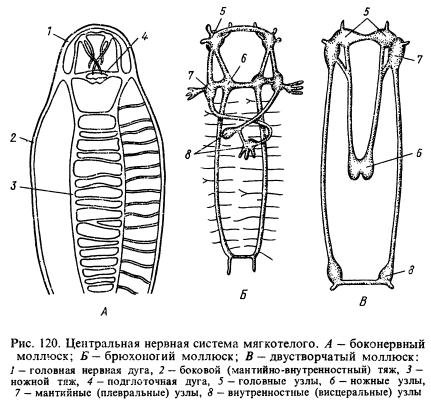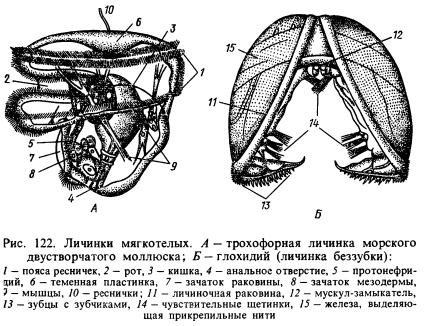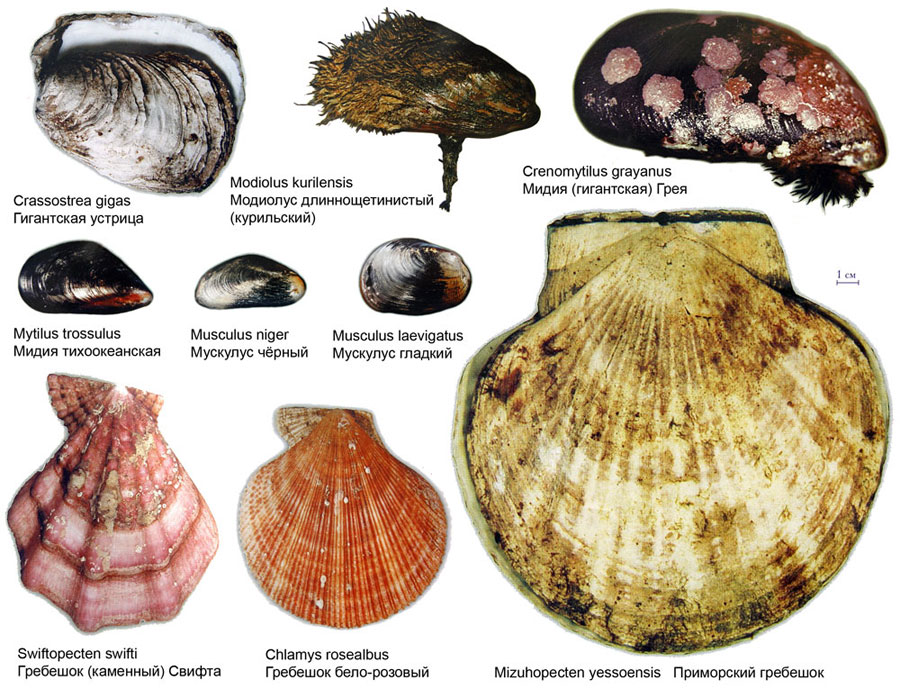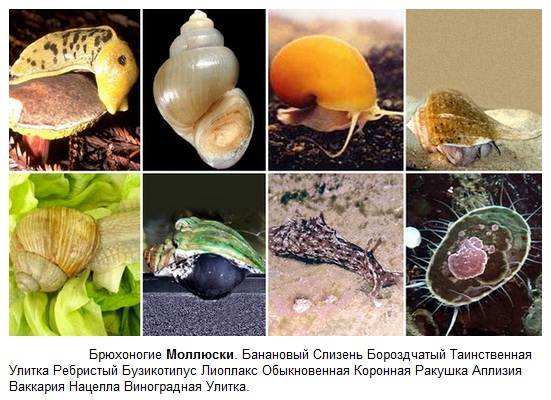28.08.2019
Mollusk type. Bivalve class. Gastropoda class. class cephalopods
Type of mollusc combines diverse groups animals. These are slowly crawling snails, and slugs, and relatively sedentary bivalves, and mobile cephalopods. They live in the seas fresh waters, less often on dry land.
Mollusks are three-layered, as a rule, bilaterally symmetrical. The body consists of a torso, head and legs. On head the eyes are located, the organs of touch are the tentacles. Leg- a muscular outgrowth of the abdominal wall of the body, on which the mollusk crawls (may disappear in inactive and sessile forms). IN torso the organs of the mollusk are located. The body of the mollusk is covered with a skin fold on the outside - mantle (salient feature shellfish). The mantle has many glands, thanks to which the body is constantly moistened, and its epithelium also secretes calcareous sink- organic passive protection. The sink consists of 3 layers - organic, calcareous and mother-of-pearl.
Between the body and the mantle is located mantle cavity, in which the respiratory organs, anal, excretory and genital openings are located. In internal structure mollusks are characterized by filling the space with parenchyma (hence the name - soft-bodied).
The digestive system is made up of radulae(horny hook-shaped outgrowths of the walls of the pharynx for crushing food), the pharynx, where the ducts open salivary glands, stomach, passing into the midgut and liver ducts involved in the digestion of food. The methods of obtaining food are varied: in mobile forms, this is predation (cephalopods, some gastropods), in inactive forms, feeding on parts of plants using a grater (gastropods), or by filtration (bivalves).
The respiratory organs are gills(modified sections of the mantle that look like petals; the wet wall of the mantle is penetrated by numerous blood vessels that exchange gases) or lungs(separate sections of the mantle cavity communicating with the air through the respiratory opening, which is locked by an annular sphincter). To ventilate the lung cavity, mollusks living in water periodically rise to its surface.
Nervous system - nodal type, consists of ganglion(nerve nodes) located in the head, leg and gills. The nodes are interconnected by nerve cords. The circulatory system is not closed, the central organ is the heart, which in most species consists of one ventricle and one or two atria (less often three or four). excretory organ - nephridia(bud). One end of it is turned into the pericardial sac, the other opens into the mantle cavity, where the excretory products are excreted. The sense organs in mollusks are developed in different ways, most well in cephalopods. This is a chemical sense, senses of smell, touch, etc. Specialized muscles move the leg and shell, skin-muscular sac No. This is mainly smooth muscle, in cephalopods it is transverse.
Among mollusks there are dioecious (most) and hermaphrodites (cross-fertilization). Development is direct or with the formation of a larva. Fertilization occurs in water conditions.
Mollusks very early separated from the ancient rings and are a dead end branch in the evolution of invertebrates. The type of shellfish includes 7 classes. The most common: bivalve, gastropods, cephalopods.
Class bivalves, or lamellar gills
More than 100,000 species are known. class representative - toothless. Lives in fresh waters. In bivalves, the head is reduced, the body (trunk and leg) is enclosed in a bivalve shell.
The circulatory system is not closed. The excretory organ is 2 kidneys. Breathing is gill. The nervous system is poorly developed, includes three pairs of nerve nodes. The head tentacles and eyes are absent. Sense organs - organs of balance, chemical sense and touch.
The meaning of bivalves:
1. Included in different digestive chains.
2. They are powerful biofilters.
3. Used by humans for food (oysters, mussels)
4. Go to receive mother-of-pearl (pearl) and pearls (pearl oysters)
5. They harm a person by clogging cleaning grates, locks, settling on other hydraulic structures (dreysevra - a river mollusk)
6. Damage to wooden ships (toredo, sharpens a tree with his head)
class gastropods
The class of gastropods includes molluscs, the body of which is enclosed in a spirally twisted shell, consisting of one valve. In this regard, gastropods are asymmetrical. Also among the representatives there are also mollusks devoid of a shell (slugs).
The body is clearly divided into head, leg and torso. On the head are tentacles and eyes. The organ of locomotion - the leg - may have different shape(for floating - a fin or blades; for crawling - a flat sole).
Respiration is carried out with the help of gills or lungs. Gastropods are dioecious or hermaphrodites. After fertilization, the eggs of pond snails are enclosed in a slimy cocoon attached to underwater objects. Grape snails and slugs lay their eggs in the ground. Most of the development is direct, some with a larval stage.
Meaning of gastropods:
1. Pests of garden and wild plants (grape snail, slugs). Snails are generally not poisoned, but collected, then ground into fodder meal.
2. In some countries they eat (grape snails)
3. Used to obtain mother-of-pearl.
The class includes squid, octopus and cuttlefish. There are about 600 species of these mollusks. Cephalopods inhabit mainly warm and full-salt seas. The largest and most perfect molluscs.
One part of the leg is turned into tentacles with suction cups that are on the head and surround mouth opening. The other part of the leg forms a funnel. The muscular mantle and funnel serve as a kind of jet engine. There are 2 siphons in the mantle, water enters there, the channel closes, and, thanks to the contraction of the muscles, there is a sharp release of water, as a result of which movement occurs.
In some cephalopods, the remains of a shell have been preserved under the skin, which disappeared due to the transition of ancestors to an active lifestyle.
In cephalopods, compared with other molluscs, the nervous system reaches its greatest development: the nerve ganglions have merged and formed a large brain. Their sense organs are highly developed. The eyes of cephalopods are similar in structure to the eyes of fish, and in terms of visual acuity they are not inferior to human eyes. high development nervous system provides these mollusks with active movement, pursuit of prey and other adaptive reactions to a constantly changing habitat.
Many cephalopods have a beak, the bite is a serious danger. There is also an ink sac that the squid uses to make a smokescreen, and it has the ability to hide or capture prey. They are one of the highest hydrobionts, one of the smartest animals of the sea.
There are giant squids - octopuses - the largest recorded - 18 m long.
1. What is the structure of the toothless shell?
The shell of a toothless tooth consists of two valves connected on the dorsal side by an elastic ligament and two closure muscles located in the anterior and posterior parts. inner surface shells. If the closing muscles contract, then the shell valves close, and they open when the closing muscles relax.
2. How does toothless eat and breathe?
Toothless, like all bivalves, is a filter feeder. Through the inlet siphon of the mantle, water is sucked in with bacteria, algae, particles of dead plant and other residues contained in it. It enters the mantle cavity, is filtered through large lamellar gills, on the surface of which food suspension remains. filtered pure water is excreted from the mantle cavity through the excretory siphon. Food particles are sent to the mouth by the beating of special rows of cilia through the gills and further into the digestive system, where they are digested and absorbed. Undigested residues enter through the anus into the excretory siphon and are brought out.
Toothless breathing is carried out with the help of large lamellar gills. The water entering through the inlet siphon washes the gills, gives them dissolved oxygen and absorbs carbon dioxide from them, removing it with filtered water through the outlet siphon. Thus, the gills of bivalve mollusks perform two functions: filtering food material and gas exchange.
3. What are the features of reproduction and development of toothless?
4. How is the leg arranged in cephalopods? What are the features of their movement?
The leg of cephalopods is transformed into tentacles with suction cups and a tubular funnel. The mantle cavity communicates with aquatic environment with the help of a gap located between the muscular mantle and the body. The funnel with its expanded lower part is immersed in the mantle cavity, and its upper, narrower part is pushed outward from the gap of the mantle cavity. When the muscles of the mantle relax, the gap expands and the mantle cavity is filled with water. When the muscles of the mantle contract, the gap closes and the water, under the pressure that has arisen, is pushed out in a strong jet through the narrow upper opening of the funnel. In this case, the animal receives a push in the direction opposite to the movement of the water jet. So, producing frequent shocks, the animal moves rapidly in the water column. This type of movement is called reactive.
5. Name the ways to protect cephalopods.
Due to the mobile way of life in the water column, cephalopods have lost their heavy shell. Therefore, they have to protect their soft body in other ways. So, mollusks are saved by a quick flight from danger; a quick change in the color of the integument of the body to match the background of the soil, which makes them invisible; the ability to form a "smoke screen", throwing the secret of the ink bag into the water, which makes the mollusk in it invisible to the attacker.
6. What are the advantages of placing gills in the mantle cavity in bivalves?
The location of the gills in the mantle cavity, in which the flow of water coming from the inlet siphon and leaving the outlet siphon, provides the possibility of gas exchange and simultaneous collection of food material by filtering water through the gills.
7. The heart rate in bivalves is 20 beats per minute, and in an octopus up to 50 beats. Why such a significant difference in heart rate?
This difference is due to the different way of life of these mollusks. bivalves move very slowly along the bottom or completely immobile and attached to the substrate. Their vital processes are slow, so there is no need for a rapid heartbeat. On the contrary, cephalopods are active predators, swimming in the water column at speeds up to 50 km/h. Muscles need a lot to work. nutrients and oxygen delivered by the blood, which is provided by more frequent contractions of the heart.

The sense organs are varied. The organs of touch are scattered in different places surface of the body, especially a lot of them on the tentacles, the edges of the mantle, etc. There are organs that perceive temperature and chemical irritations, statocysts that perceive changes in the position of the body in space. Most representatives of the type under consideration have eyes, and their structure is different: from very simple organs to eyes (in cephalopods), which in their complexity approach the eyes of vertebrates. In many soft-bodied gastropods, these organs are located on the head tentacles. Some bivalve soft-bodied eyes may be located at the edges of the mantle or in other open places.

Propulsion system. The motor system is quite well developed, but almost always consists of smooth muscle fibers, and the movement of molluscs is usually slow. It is precisely in connection with this that soft-bodied shells have developed that protect them from attacks by predators. The movement of molluscs occurs as a result of wave-like contractions of the leg muscles; it is relieved by profuse mucus. Other parts of the body are also mobile to some extent. Particularly mobile are the tentacles found on the head of many species, the anterior part of the body, the anterior part of the digestive apparatus, some parts of the reproductive apparatus, etc. Movement different parts the body is provided by the presence of numerous muscle bundles (Fig. 121). Peculiar very fast way movement is characteristic cephalopods(see below). The muscles that close the valves of the shells are very powerful, especially in large mollusks.
Circulatory system. The circulatory system is well developed. The blood is set in motion heart(see Fig. 118, 121), which in most soft-bodied consists of one atrium and one ventricle. In other representatives of the type, the heart can be three-chambered (two atria and one ventricle) and four-chambered (two atria and two ventricles). The heart is surrounded by a special bag - pericardial sac, or pericardium. The cavity of the pericardial sac is the remnant of the coelom. The heart of mollusks in its structure resembles the heart of vertebrates. Blood enters the heart from the respiratory organs, i.e., rich in oxygen, and is carried throughout the body. The network of blood vessels is developed to varying degrees: in some it is more, in others it is less, but in all soft-bodied it is not closed, and blood flows into the spaces between the organs. Thus, soft-bodied hearts are better developed and have a more complex structure than active animals such as arthropods. However, in the latter, blood circulation is facilitated due to the presence of a more perfect motor system. As a whole it is strongly reduced. In addition to the pericardium, it is preserved in the cavity of the gonads.
Respiratory system. Soft-bodied, like most arthropods, have special respiratory organs. Skin respiration, characteristic of sponges, coelenterates and most worms, does not play a significant role in mollusks, since a significant part of their body is covered by a shell, and the complex organism of these animals needs special devices to supply oxygen. The primary soft-bodied have thin lamellar outgrowths well supplied with blood - gills. The structure of these organs is different: from very simple outgrowths to complex plates interconnected. The gills lie on the sides of the body or at the anterior or posterior ends. The change of water near the gills occurs due to the flickering of cilia on their surface, as well as as a result of other adaptations. Various outgrowths of the body located in those parts of the body where water access and its change occur quite easily can also play the role of gills.
In terrestrial soft-bodied respiratory organs are the lungs (Fig. 121) - extensive bags formed by the mantle. These organs are connected to external environment with the help of a periodically opening pulmonary opening. In the mantle wall of the lung, blood vessels branch out abundantly, through the walls of which the exchange of gases takes place. The lungs are also preserved in those aquatic soft-bodied animals that descended from terrestrial ancestors. Such secondary aquatic animals rise to the surface of the water and absorb atmospheric oxygen. In addition, they have developed and skin respiration.
excretory system. The main excretory organs are rather large organs - the kidneys (Fig. 121), which in their structure resemble metanephridia. Most soft-bodied have one kidney, a minority have two. The kidney opens into the pericardium, i.e., like the metanephridia, it communicates with the coelom. The kidney is closely related to circulatory system and absorbs dissimilation products from the blood, which it releases to the outside through a special channel - the ureter (Fig. 121), sometimes very long. In addition, in the body of molluscs there are special glands that absorb dissimilation products.
Digestive system. The digestive system in relation to the general pretty high level organizations are complex (Fig. 121). In the oral cavity, which directly passes into the large pharynx, most mollusks have devices for the mechanical processing of food: a grater (radula) and jaws. The grater is seated with many cloves. In herbivores, it serves to slough off layers of plant tissue; in a number of predatory forms, its teeth are elongated and bent backwards and play an important role in capturing prey. The teeth of the grater are chitinous, very durable. The jaws are horny and developed, depending on the nature of the diet, in different ways. The ducts of highly developed salivary glands flow into the oral cavity, the juice of which serves to envelop food and contains some digestive enzymes. In a number of predatory soft-bodied, the anterior end of the digestive tube can protrude in the form of a trunk that penetrates into the victim's body. The pharynx passes into a thin-walled esophagus, expanding in many forms into a goiter. Next comes a more or less long midgut, the initial section of which can often turn into a sac-like stomach. In many soft-bodied epithelium of a special outgrowth of the back of the stomach forms a transparent, gelatinous stick - a "crystal column" that protrudes into the stomach cavity. As a result of the dissolution of the tip of the column, digestive enzymes are released under the influence of gastric juice. Usually a highly developed liver is connected to the intestine, the role of which is diverse: the juices secreted by it contain digestive enzymes, it promotes the absorption of digested food, organic substances accumulate in it, etc. The middle intestine passes into the back, ending in the anus. The anus of mollusks, in which the body is in a spirally twisted shell (most gastropods) or the back of the body is closed on all sides (in cephalopods), opens not at the back, but at the front of the body. In such molluscs, the intestines are strongly curved and both openings - oral and anal - are not far from each other. The nature of the nutrition of soft-bodied animals is diverse: some feed on animal food, others live off plant organisms, and the nutrition of others is mixed.
There are many predators among mollusks that actively capture different ways prey - other animals. Bivalve mollusks and some other groups of the type feed on planktonic organisms, which are carried away into the alimentary canal of mollusks by the current of water. The latter arises as a result of the movement of cilia located on the gills and other parts of the body.


It is interesting to note that, like in higher mollusks, neopilina has a well-developed grater and liver, and there is a crystal column in the stomach. The gonads are two pairs, neopilins are separate sexes, fertilization is external, gametes go outside through the excretory organs. Thus, the organization of neopilin combines primitive features (the structure of the nervous system, a well-preserved coelom, incomplete development of the heart, etc.), moderate metamerism of a number of organs (muscles, coelom, metanephridia, etc.) and features of real molluscs (especially digestive system). The study of neopilin strengthened the opinion of those scientists who believed that soft-bodied worms originated from low-segmented (oligomeric) secondary cavity worms.
Primitive soft-bodied probably arose when annuli and arthropods did not yet exist and, therefore, they did not have strong competitors. Therefore, sinks passive protection weren't needed. Later, when rings appeared, and then arthropods, shells began to develop in mollusks, because with the slowness of their movement it was difficult for them to “compete” with animals so dangerous to them, moreover, better protected. All this led to the disappearance of the metamerism of some organs, characteristic of the lowest groups of soft-bodied animals, the movement of which was entirely provided by a special part of the body - the leg, and not the whole body.




